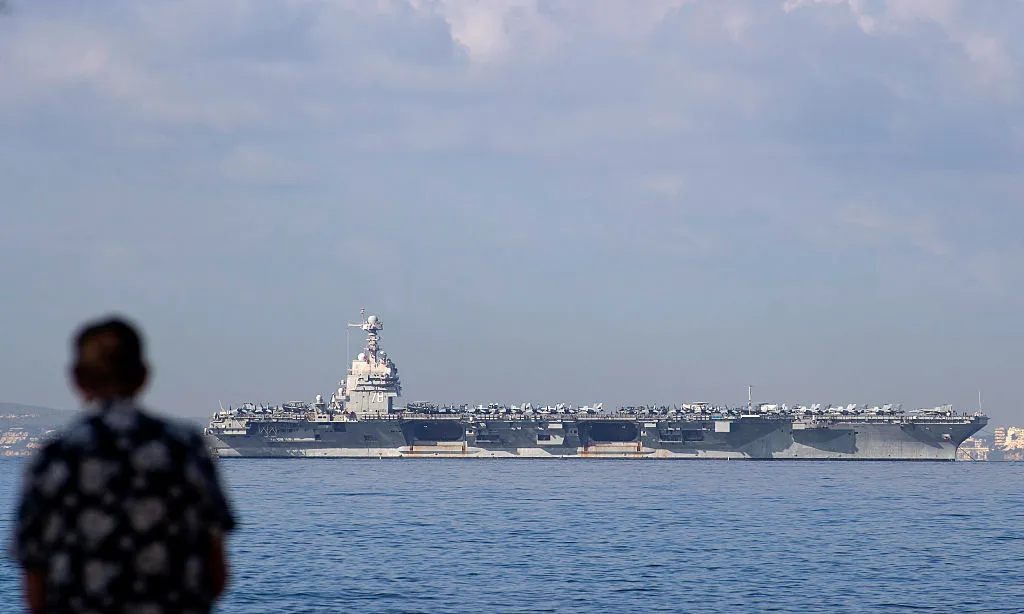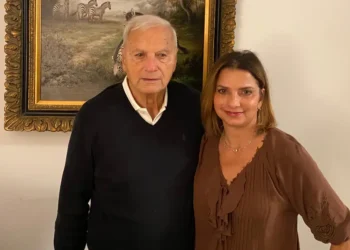
The United States Navy’s most advanced aircraft carrier has arrived in the Latin American region, officials said on Tuesday, capping a months-long military build-up that has coincided with increased threats against Venezuela from the Trump Administration.
The Pentagon said the deployment of the U.S.S. Gerald R. Ford, the largest and most advanced aircraft carrier in the world, would “enhance and augment existing capabilities to disrupt narcotics trafficking and degrade and dismantle transnational criminal organisations.”
The carrier joins eight warships, a nuclear submarine, F-35 jets, and some 10,000 U.S. personnel already deployed to the region in previous months, who have been carrying out what the Trump Administration has called a “non-international armed conflict” against “narcoterrorists,” which the Trump Administration claims are supported by the Venezuelan government.
Read More: Trump’s Caribbean Bombing Campaign Brings War on Terror to the Americas
The Administration first launched strikes against alleged cartel boats in the Caribbean Sea in September, alleging that Tren de Aragua (TDA) members were aboard. More than a dozen ships near Venezuelan waters have been attacked in the months since, killing more than 75 people and forcing the Latin American country to enact its own protective measures as U.S. officials weigh the possibility of launching land strikes.
The U.S. government has not released any evidence indicating that any of the ships attacked were smuggling drugs.
The Administration’s operation against the cartels has since threatened to spiral into a wider conflict with Venezuela. President Donald Trump has denied he is seeking regime change, but has consistently called Venezuelan President Nicolas Maduro an illegitimate leader and accused him of supporting the cartels.
As the U.S. has steadily increased the number of troops in the region, Trump has threatened to strike inside Venezuela, reportedly to target drug production, and authorized the Central Intelligence Agency (CIA) to carry out covert missions in the country.
“We are certainly looking at land now, because we’ve got the sea very well under control,” Trump told the press in October.
Maduro has accused Trump of pushing for a war against Venezuela.
“They promised they would never again get involved in a war and they are fabricating a war that we will avoid,” he said in a national broadcast last month.
Here’s how the country is reportedly preparing for possible U.S. air strikes.
Mobilization and high alert
Venezuelan Defense Minister Vladimir Padrino López on Tuesday announced a plan to place the country’s military on “full operational readiness,” calling for the deployment of all land, air, riverine, and missile assets, as well as the country’s militia, through Wednesday.
“The aggression will be responded to with national unity,” López said. “We are ready here, we don’t want war.”
The deployment advances Maduro’s “Independence Plan 200,” a military order enacted in response to the United States’ increased presence in the Caribbean. Padrino said the deployment was being done to “confront imperial threats.”
Last month, Venezuelan officials announced that they had started training civilians for military operations. Estimates indicate that the country has some 340,000 members of the armed forces, compared to the 1.3 million active-duty U.S. personnel.
The “peasant militia” group was sworn in by Interior Minister Diosdado Cabello in October.
The civilian arm of the Venezuelan militia was first created under former Venezuelan President Hugo Chavez to help defend the country, though it did not receive the same level of training as other active military personnel.
Preparing for guerrilla warfare
Venezuelan war planning has gone so far as to include a plan for a full ground invasion by U.S. forces.
Officials with knowledge of Venezuela’s defense forces told Reuters that the country is considering launching a guerrilla-style war—a tactic used in the South American countries of Peru and Colombia— should the country face a foreign attack.
Guerrilla warfare involves small-scale actions by political forces that either operate independently or in collaboration with a broader political strategy to attack an opposing side.
Venezuela would reportedly send smaller military units to more than 280 locations across the country in anticipation of a “prolonged resistance,” according to the report.
Venezuelan officials are also looking at another strategy known as “anarchization.” Under that plan, the government would use its intelligence and supporters to cause chaos in the country, making it difficult to govern in the event that it is overthrown.
An app to report suspicious behavior
The Venezuelan government is finding novel ways to fight back against potential U.S. spying in the run-up to a potential attack.
It has repurposed an app previously used as a service helpline for residents to report utility malfunctions into a tool for reporting suspicious behaviour by fellow citizens. It comes after Trump confirmed he had authorized covert CIA actions in Venezuela, ostensibly to stop drugs coming into the United States.
VenApp was used last year to report political dissidents questioning the validity of Maduro’s second re-election to their federal government, according to global charity Amnesty International.
But more recently, Maduro invited military forces in October to oversee the design of a new mobile app that would allow residents to “safely report everything they hear, everything they read,” CNN reports. That includes informing the government of drones, “suspicious people,” or actions that they may deem as proof of disloyalty.
Asking for foreign aid
For many years, Venezuela has relied on aid from foreign powers to supplement its military forces, be it missiles from Iran and Russia, or Chinese armored vehicles.
Amid a possible showdown with the U.S., one of the most powerful military forces in the world, it has begun seeking help from those same allies to bolster its capabilities again, requesting “defensive radars, aircraft repairs and potentially missiles,” according to the Washington Post.
In October, the Venezuelan President reached out to China, Iran, and Russia for help, the Post reported.
The Russian Foreign Ministry said in response to the reported requests that Russia is “ready to respond appropriately to the requests of our partners in light of emerging threats.”
According to the Financial Times, both Venezuelan servicemen and the arsenal and vehicles are poorly maintained and not ready for a serious conflict. Poor maintenance of weapons, helicopters, and other military equipment also points to a weaker national military system.
The post How Venezuela is Preparing for the Possibility of a U.S. Attack appeared first on TIME.



